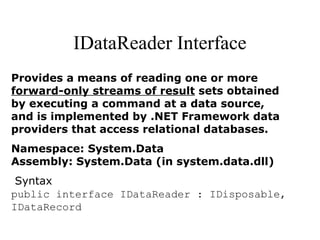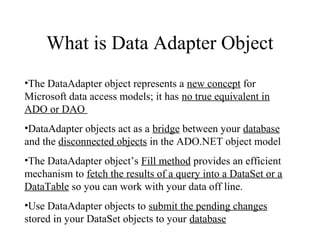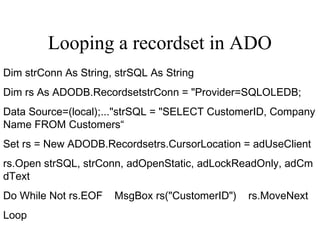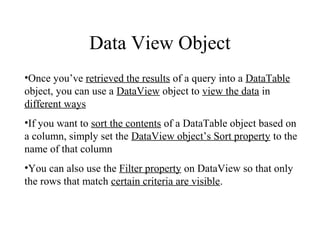Introduction to ADO.NET
- 2. Introduction ADO.NET is a set of libraries included with the Microsoft .NET Framework that help you communicate with various data stores from .NET applications
- 3. Objectives of ADO.NET The ADO.NET libraries include classes for •connecting to a data source, •submitting queries, and •processing results. •You can also use ADO.NET as a robust, hierarchical, disconnected data cache to work with data off line.
- 4. Evolution of Technology Visual Basic 3 Data Access Objects (DAO). (local file-based databases) Visual Basic 4 Remote Data Objects (RDO). (larger server-based databases) Visual Basic 5 and Visual Studio 97 ODBCDirect Visual Basic 6 and Visual Studio 6 ADO
- 5. Why ADO.NET ? •ADO will never handle XML data as efficiently as ADO.NET does •You cannot combine the contents of multiple Recordset objects in ADO •The ADO cursor engine does not, for example, provide a way to submit pending changes to your database via stored procedures •ADO allows you to submit cached changes to databases, but it does not give you control over the logic used to submit updates •ADO was built for COM-based application
- 6. Benefits of ADO.NET • greater XML support, • easier disconnected data access, • more control over updates, and • greater update flexibility
- 7. ADO Vs ADO.NET •In ADO, the Recordset object stores the results of your queries. You can call its Open method to fetch the results of a query and call its Update (or UpdateBatch) method to submit changes stored within the Recordset to your database •The objects that comprise the disconnected half of the ADO.NET object model do not communicate directly with the connected objects. This is a major change from previous Microsoft data access object models
- 9. Data Set The central disconnected object, DataSet, allows you to sort, •search, •filter, •store pending changes, and •navigate through hierarchical data •Work with XML
- 10. Dataset Vs Recordset •The ADO.NET DataSet, is comparable in functionality to the ADO Recordset • However, the DataSet does not communicate with your database • In order to fetch data from your database into a DataSet, you pass the DataSet into the Fill method of a connected ADO.NET object—the DataAdapter. • Similarly, to submit the pending changes stored in your DataSet to your database, you pass the DataSet to the DataAdapter object’s Update method
- 11. What is a Data Provider •A .NET data provider is a collection of classes designed to allow you to communicate with a particular type of data store •The .NET Framework includes three such providers, the SQL Client .NET Data Provider , the Oracle Client and the OLE DB .NET Data Provider. •Third party DB vendors provide their own Data providers like Oracle’s Data Provider for .NET (ODP.NET) •The OLE DB .NET Data Provider lets you communicate with various data stores through OLE DB providers •The SQL Client .NET Data Provider is designed solely to communicate with SQL Server databases, version 7 and later.
- 12. What is common to all Data Providers •Each .NET data provider implements the same base classes— Connection, Command, DataReader, Parameter, and Transaction—although their actual names depend on the provider •For example, the SQL Client .NET Data Provider has a SqlConnection object, and the OLE DB .NET Data Provider includes an OleDbConnection object •Regardless of which .NET data provider you use, the provider’s Connection object implements the same basic features through the same base interfaces
- 13. Data Provider Namespaces Each .NET data provider has its own namespace •System.Data.OleDb •System.Data.SqlClient •System.Data.OracleClient
- 14. IDbConnection Interface Represents an open connection to a data source, and is implemented by .NET Framework data providers that access relational databases. Namespace: System.Data Assembly: System.Data (in system.data.dll) Syntax public interface IDbConnection : IDisposable
- 15. IDataAdapter interface Allows an object to implement a DataAdapter, and represents a set of methods and mapping action- related properties used to fill and refresh a DataSet and update a data source. Namespace: System.Data Assembly: System.Data (in system.data.dll) C# Syntax public interface IDataAdapter
- 16. IDbDataAdapter Interface Represents a set of command-related properties that are used to fill the DataSet and update a data source, and is implemented by .NET Framework data providers that access relational databases. Namespace: System.Data Assembly: System.Data (in system.data.dll) Syntax public interface IDbDataAdapter : IDataAdapter
- 17. IDataReader Interface Provides a means of reading one or more forward-only streams of result sets obtained by executing a command at a data source, and is implemented by .NET Framework data providers that access relational databases. Namespace: System.Data Assembly: System.Data (in system.data.dll) Syntax public interface IDataReader : IDisposable, IDataRecord
- 18. IdbCommand Interface Represents an SQL statement that is executed while connected to a data source, and is implemented by .NET Framework data providers that access relational databases. Namespace: System.Data Assembly: System.Data (in system.data.dll) Syntax public interface IDbCommand : IDisposable
- 19. IDbTransaction Interface Represents a transaction to be performed at a data source, and is implemented by .NET Framework data providers that access relational databases. Namespace: System.Data Assembly: System.Data (in system.data.dll) Syntax public interface IDbTransaction : IDisposable
- 21. Parameter Object Query without parameters : SELECT CustomerID, CompanyName, Compa nyName, Phone FROM Customers WHERE CustomerID = 'ALFKI' Query with parameters : SELECT CustomerID, CompanyName, Compa nyName, Phone FROM Customers WHERE CustomerID = ? To use a parameterized Command object, you create Parameter objects for each of the parameters in your query and append them to the Command object’s Parameters collection
- 22. What is Data Adapter Object •The DataAdapter object represents a new concept for Microsoft data access models; it has no true equivalent in ADO or DAO •DataAdapter objects act as a bridge between your database and the disconnected objects in the ADO.NET object model •The DataAdapter object’s Fill method provides an efficient mechanism to fetch the results of a query into a DataSet or a DataTable so you can work with your data off line. •Use DataAdapter objects to submit the pending changes stored in your DataSet objects to your database
- 23. Command Builder •The ADO.NET DataAdapter object exposes a number of properties that are actually Command objects. •For instance, the SelectCommand property contains a Command object that represents the query you’ll use to populate your DataSet object. •The DataAdapter object also has UpdateCommand, InsertCommand, and DeleteCommand properties that correspond to Command objects you use when you submit modified, new, or deleted rows to your database, respectively
- 24. DataAdapter.Update •With a DataAdapter object, you can set the UpdateCommand, InsertCommand, and DeleteCommand properties to call the stored procedures that will modify, add, or delete rows in the appropriate table in your database. •Then you can simply call the Update method on the DataAdapter object and ADO.NET will use the Command objects you’ve created to submit the cached changes in your DataSet to your database
- 25. Data Table Object •The ADO.NET DataTable object is similar to the ADO and DAO Recordset objects. •A DataTable object allows you to examine data through collections of rows and columns. •You can store the results of a query in a DataTable through the DataAdapter object’s Fill method
- 26. Populating a Data Table string strSQL = "SELECT CustomerID, CompanyName FRO M Customers"; string strConn = "Provider=SQLOLEDB;Data Source=(local);.. .“ OleDbDataAdapter daCustomers = new OleDbDataAdapter(s trSQL, strConn); DataTable tblCustomers = new DataTable();daCustomers.Fill (tblCustomers);
- 27. DataRow and DataColumn •Once you’ve fetched the data from your database and stored it in a DataTable object, that data is disconnected from the server •You access the contents of a DataTable through its Rows property, which returns a collection of DataRow objects •If you want to examine the structure of a DataTable, you use its Columns property to retrieve a collection of DataColumn objects •The DataTable class also lets you define constraints, such as a primary key, on the data stored within the class
- 28. Data Column Object •Each DataTable has a Columns collection, which is a container for DataColumn objects. •The Columns collection and DataColumn objects can be roughly compared to the Fields collection and Field objects in ADO and DAO. •However, a DataColumn object doesn’t actually contain the data stored in your DataTable. Instead, it stores information about the structure of the column •For example, DataColumn exposes a Type property that describes the data type (such as string or integer) that the column stores. •DataColumn has other properties such as ReadOnly, AllowDBNull, Unique, Default, and AutoIncrement
- 29. Expression property •The DataColumn class also exposes an Expression property, which you can use to define how the data in the column is calculated •DataColumn col = new DataColumn(); •col.ColumnName = "ItemTotal"; •col.DataType = typeof(Decimal); •col.Expression = "UnitPrice * Quantity";
- 30. Data Row Object •To access the actual values stored in a DataTable object, you use the object’s Rows collection, which contains a series of DataRow objects •DataRow row; •row = MyTable.Rows[0]; •Console.WriteLine(row[0]); •Console.WriteLine(row["CustomerID"]); •Console.WriteLine(row[MyTable.Columns["CustomerID"]]) ;
- 31. Looping a recordset in ADO Dim strConn As String, strSQL As String Dim rs As ADODB.RecordsetstrConn = "Provider=SQLOLEDB; Data Source=(local);..."strSQL = "SELECT CustomerID, Company Name FROM Customers“ Set rs = New ADODB.Recordsetrs.CursorLocation = adUseClient rs.Open strSQL, strConn, adOpenStatic, adLockReadOnly, adCm dText Do While Not rs.EOF MsgBox rs("CustomerID") rs.MoveNext Loop
- 33. Updation and DataRow •The DataRow object is also the starting point for your updates •You can call the BeginEdit method of a DataRow object, change the value of some columns in that row through the Item property, and then call the EndEdit method to save the changes to that row •When you change the contents of a row, the DataRow object caches those changes so that you can submit them to your database at a later time
- 34. DataSet Object •You can think of a DataSet object as the container for a number of DataTable objects (stored in the DataSet object’s Tables collection) •Any changes you make to the data are simply cached in each DataRow •You can use the GetChanges method to extract just the modified rows from your DataSet to update the Database •You can use the DataSet class’s Merge method to combine the contents of two DataSet objects into a single DataSet •You can create a DataSet object and populate its Tables collection with information without having to communicate with a database
- 35. Data Relation Object •You can use a DataRelation object to indicate a relationship between different DataTable objects in your DataSet •DataSet dsNorthwind; •dsNorthwind.Relations.Add("CustomersOrders",dsNorthwind.Tabl es["Customers"].Columns["CustomerID"], dsNorthwind.Tables["Or ders"].Columns["CustomerID"]); •foreach (DataRow rowCustomer in dsNorthwind.Tables["Custom ers"].Rows) •{Console.WriteLine("Orders for customer " + • rowCustomer["CompanyName"].ToString()); •foreach (DataRow rowOrder in rowCustomer.GetChildRows("Cus tomersOrders"))
- 36. Data View Object •Once you’ve retrieved the results of a query into a DataTable object, you can use a DataView object to view the data in different ways •If you want to sort the contents of a DataTable object based on a column, simply set the DataView object’s Sort property to the name of that column •You can also use the Filter property on DataView so that only the rows that match certain criteria are visible.
- 37. Typed Data Set •Let’s say we have a simple table named Orders that contains two columns, CustomerID and CompanyName. •DataSet ds; • DataSet.Console.WriteLine(ds.Tables["Customers"] .Rows[0]["CustomerID"]); •Can be replaced by a Strongly Typed data set : •CustomersDataSet ds; •Console.WriteLine(ds.Customers[0].CustomerID);
- 38. Another Typed Data Set Before using Typed Data Set : DataSet ds; DataRow rowNewCustomer; rowNewCustomer = ds.Tables["Customers"].NewRow(); rowNewCustomer["CustomerID"] = "ALFKI";rowNewCustomer[" CompanyName"] = "Alfreds Futterkiste"; ds.Tables["Customers"].Rows.Add(rowNewCustomer); After using Typed Data set: ds.Customers.AddCustomersRow("ALFKI", "Alfreds Futterkiste")





























![Data Row Object
•To access the actual values stored in a DataTable object, you
use the object’s Rows collection, which contains a series of
DataRow objects
•DataRow row;
•row = MyTable.Rows[0];
•Console.WriteLine(row[0]);
•Console.WriteLine(row["CustomerID"]);
•Console.WriteLine(row[MyTable.Columns["CustomerID"]])
;](https://image.slidesharecdn.com/ado-net-101109020011-phpapp02/85/Introduction-to-ADO-NET-30-320.jpg)

![Looping a DataTable
string strSQL, strConn;
...
OleDbDataAdapter da = new OleDbDataAdapter(strSQL, strC
onn);
DataTable tbl = new DataTable();
da.Fill(tbl);
foreach (DataRow row in tbl.Rows)
Console.WriteLine(row[0]);](https://image.slidesharecdn.com/ado-net-101109020011-phpapp02/85/Introduction-to-ADO-NET-32-320.jpg)


![Data Relation Object
•You can use a DataRelation object to indicate a relationship between
different DataTable objects in your DataSet
•DataSet dsNorthwind;
•dsNorthwind.Relations.Add("CustomersOrders",dsNorthwind.Tabl
es["Customers"].Columns["CustomerID"], dsNorthwind.Tables["Or
ders"].Columns["CustomerID"]);
•foreach (DataRow rowCustomer in dsNorthwind.Tables["Custom
ers"].Rows)
•{Console.WriteLine("Orders for customer " +
• rowCustomer["CompanyName"].ToString());
•foreach (DataRow rowOrder in rowCustomer.GetChildRows("Cus
tomersOrders"))](https://image.slidesharecdn.com/ado-net-101109020011-phpapp02/85/Introduction-to-ADO-NET-35-320.jpg)

![Typed Data Set
•Let’s say we have a simple table named Orders that
contains two columns, CustomerID and CompanyName.
•DataSet ds;
• DataSet.Console.WriteLine(ds.Tables["Customers"]
.Rows[0]["CustomerID"]);
•Can be replaced by a Strongly Typed data set :
•CustomersDataSet ds;
•Console.WriteLine(ds.Customers[0].CustomerID);](https://image.slidesharecdn.com/ado-net-101109020011-phpapp02/85/Introduction-to-ADO-NET-37-320.jpg)
![Another Typed Data Set
Before using Typed Data Set :
DataSet ds;
DataRow rowNewCustomer;
rowNewCustomer = ds.Tables["Customers"].NewRow();
rowNewCustomer["CustomerID"] = "ALFKI";rowNewCustomer["
CompanyName"] = "Alfreds Futterkiste";
ds.Tables["Customers"].Rows.Add(rowNewCustomer);
After using Typed Data set:
ds.Customers.AddCustomersRow("ALFKI", "Alfreds Futterkiste")](https://image.slidesharecdn.com/ado-net-101109020011-phpapp02/85/Introduction-to-ADO-NET-38-320.jpg)